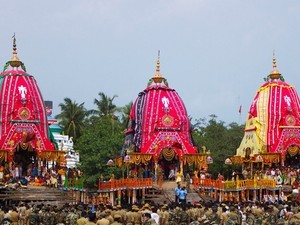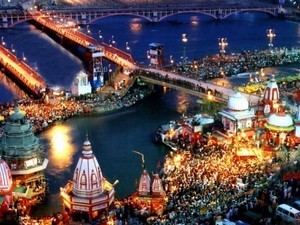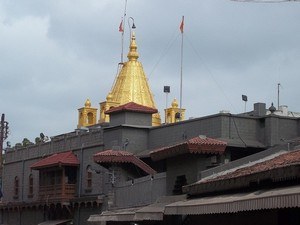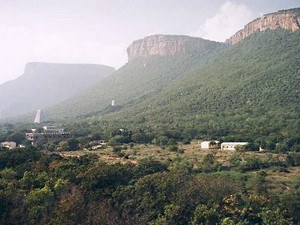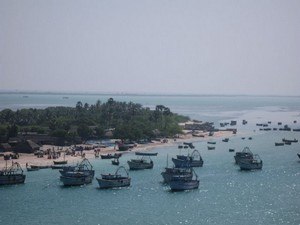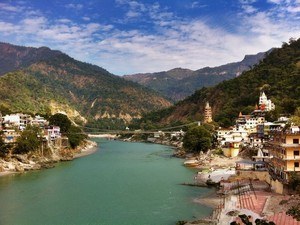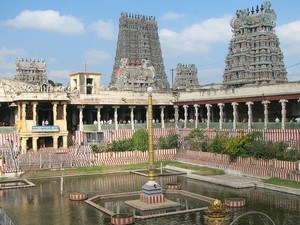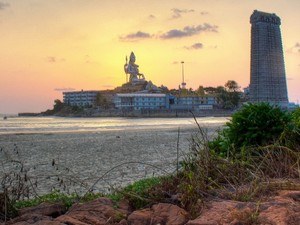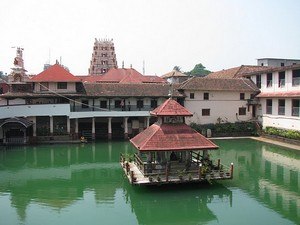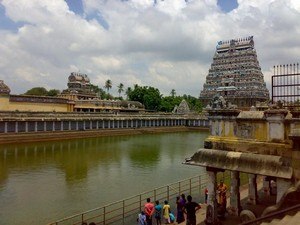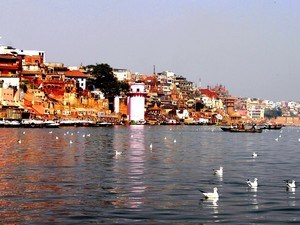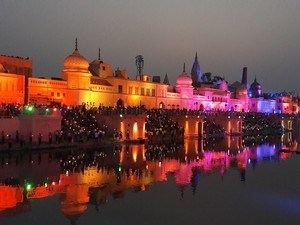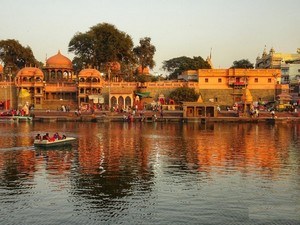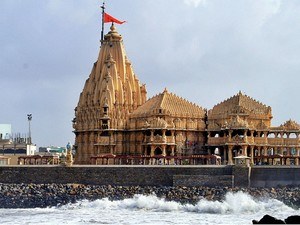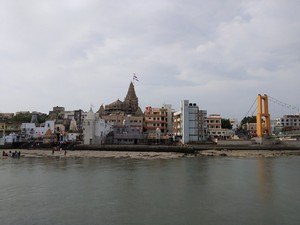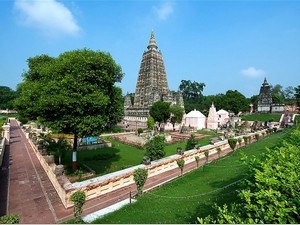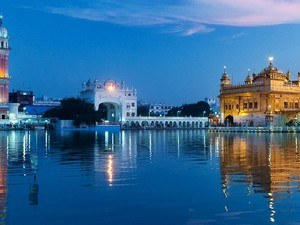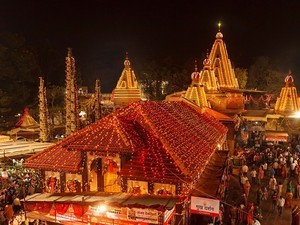1
DAY 1 : TRAVEL TO ALAMPUR & SIGHTSEEING
DAY 1 : TRAVEL TO ALAMPUR & SIGHTSEEING
 Sightseeing
Sightseeing
Leisure / No Sightseeing
At a distance of 1 km from Alampur Bus Station, Kudala Sangameswara Temple is the most magnificent of the temples at Alampur. It was built in 740 AD by Chalukya ruler Pulakesi II.
The temple was originally located at the point where Tungabhadra and Krishna Rivers were merged, 10 kms away from the current site. The temple was dismantled and built exactly rock-to-rock in the current site in 1979, as the original site was getting submerged due to the construction of Srisailam Dam.
The Sangameswara Temple is a wonderful structure with beautiful carvings on all corners. Built in Nagara style, the temple is built on an elevated platform with fortified wall around the temple. The temple has got large hall with 12 pillars followed by the sanctum. There is a circumambulatory path around the sanctum for pradakshinas. The ceiling has a large relief of Nagaraja, as seen in other .....
 Duration of visit: 30 Mins
Duration of visit: 30 Mins
 Timings: 8 AM to 6 PM
Timings: 8 AM to 6 PM
At a distance of 2 kms from Alampur Bus Station, Papanasi Temples are a group of wonderful temples dedicated to Lord Shiva. These temples are known for beautiful carvings.
Originally built on the banks of Tungabhadra River, the temples were moved to the current location during the construction of Srisailam Dam. The group of 24 temples were developed between 6th and 10th centuries. The main shrine called Papanaseswara was built by Chalukyas in the 6th century while the remaining temples were constructed by Rashtrakutas between 9th and 10th centuries. Built in Dravida and Phamsana styles, the site has two main temples and remaining are sub-shrines.
The main shrine of Papanaseswara has a large pillared mandapa and sanctum with Shivalinga. There are sub-shrines of Ganesha and Saptamatrukas on each side. The important art work in this temple includes Vamana avatara, Ashtadikpalakas, Mahishasura Mardhini, Ramayana scenes, .....
 Duration of visit: 30 Mins
Duration of visit: 30 Mins
 Timings: 8 AM to 6 PM
Timings: 8 AM to 6 PM
At a distance of 1 km from Alampur Bus Station, Bala Brahma Temple or Bala Brahmeswara Temple near Jogulamba Temple is the largest and most striking temple of the Navabrahma group of temples. This is the only temple where majority of the sculptures are found in good shape.
Built in 7th century by Chalukya ruler Pulakesi II, the temple had several additions during Vikramadita period in 755 AD. Constructed in Nagara style, there temple has large pillared varandah on all sides for outer pradakshinas. The temple has large mukha mandapa, mahamandapa and sanctum with circumambulatory path for inner pradakshinas. The shivalinga in this shrine is seen in the shape of a bull's footprint.
The doorway of inner sanctum has Dwarapalakas, Lion images along with Goddess Lakshmi, Ardhanareeswara, Vinayaka, Kalabhairava, etc. The inner mandapa has engraved figures of Mahishasura mardhini, Saptamatrukas, Indra and Agni along with a large dancing Shiva on the ceiling. The pillar has Yogamurthi .....
 Duration of visit: 30 Mins
Duration of visit: 30 Mins
 Timings: 8 AM - 1 PM & 3 PM - 8 PM
Timings: 8 AM - 1 PM & 3 PM - 8 PM
At a distance of 1 km from Alampur Bus Station, Garuda Brahma Temple is situated towards southern side of Bala Brahma Temple.
Built in Nagara style on an elevated platform, the temple has a small mukhamandapa, a large mahamandapa with 18 pillars and a sanctum with circumambulatory path. The ceiling of the mahamandapa has carving of Nagabandha with seven heads. The doorway of the sanctum has Garuda, Ganga and Yamuna. Above the doorway, there is an image of Brahma performing penance. The round pillars of the hall have floral designs and human figures. There is a small nandi installed in the mahamandapa facing the sanctum.
The four-pillared mukhamandapa is accompanied by dwarapalakas. The outer walls have carvings of Toranas, Warriors, Gandharvas and Nagas. The sukhanasi has a round circle, probably left incomplete.
Garuda Brahma Temple can be approached from the path on southern corridor of Bala Brahma Temple. There are several shrines housed in mandapa on northern side .....
 Duration of visit: 5 Mins
Duration of visit: 5 Mins
 Timings: 8 AM to 6 PM
Timings: 8 AM to 6 PM
At a distance of 1 km from Alampur Bus Station, Jogulamba Temple dedicated to Shakti is the prime religious attraction of Alampur. Being the 5th Maha Shaktipeeta, this place is highly regarded and very important religious site for Hindus. Situated past Balabrahma Temple, this temple was destroyed by Bahamani sultan in 14th century and the deity was moved to Balabrahma temple. The current structure was built in 2005 on original site and the deity was moved back to the temple. Adi Sankaracharya installed Srichakra in the original temple in 8th century which could not be recovered after destruction.
The temple complex has a main entrance with a tower, large open area followed by the main shrine. The main structure is built on an elevated platform with a large mandapa followed by the inner sanctum. Constructed in Nagara style, the architecture of original temple is followed to build this temple. There is a large water pool around the temple.
Jogulamba .....
 Duration of visit: 30 Mins
Duration of visit: 30 Mins
 Timings: 8 AM - 1 PM & 3 PM - 8 PM
Timings: 8 AM - 1 PM & 3 PM - 8 PM
At a distance of 1 km from Alampur Bus Station, Swarga Brahma Temple is a wonderful temple situated behind Bala Brahma Temple. This temple has extensive art work on the wall and pillars. Several figures were demolished during the attack in 14th century.
Built on an elevated platform, the temple has a small mukhamandapa, large pillared mahamandapa and a sanctum. There is a nandi statue installed an elevated platform opposite to the shrine. The sanctum has a circumambulatory path for pradakshinas. Built in nagara style, the vimana over sanctum has well preserved tower.
The doorway of the sanctum has figures of Ganga, Yamuna with their vehicles along with Nagendra. The circumambulatory path has images of Ganesha, Nagendra, Subrahmanya, Ducks and Lotus flowers. The ceiling of the mahamandapa has Nagabandha. The pillars have several engraved human figures. Some of these figures represent men riding lion and few mythical animals. There are statues of Ganesha, Maharshis spread in .....
 Duration of visit: 15 Mins
Duration of visit: 15 Mins
 Timings: 8 AM to 6 PM
Timings: 8 AM to 6 PM
At a distance of 1 km from Alampur Bus Station, Kumara Brahma Temple is situated toward southern side of Arka Brahma Temple, exactly opposite to the museum.
Built in Nagara style, this temple is built on a high elevated platform. This shrine possesses few wonderful sculptures on the pillars. The temple has a mukhamandapa with four pillars followed by the mahamandapa and inner sanctum with circumambulatory path.
There is an image of lord Vishnu on the doorway of the sanctum along with floral Toranas. The doorway is also decorated with Ganga, Yamuna and Nagendra. The pillars inside the mahamandapa have beautiful carvings of Gajalakshmi, Umamaheswara, Kubera, Elephants, Swans, Human riding mythical animals, etc. There is a sculpture of Saptamatrukas placed in the mahamandapa.
The pillars of mukhamandapa have wonderfully carved figures of Gandharvas, Kubera, Vinayaka, Celestial couples, Toranas and floral designs. The doorway of the mukha mandapa has seven female heads .....
 Duration of visit: 15 Mins
Duration of visit: 15 Mins
 Timings: 8 AM to 6 PM
Timings: 8 AM to 6 PM
At a distance of 1 km from Alampur Bus Station, Arka Brahma Temple is situated on southern side of Vira Brahma Temple. It was built by Chalukya ruler Vikramaditya I in 7th century.
Built in Nagara style, the vimana of the temple was destroyed during Bahamani Sultan attack in 14th century. The shrine has a mahamandapa followed by the sanctum with circumambulatory path. Appears plain outside, the temple has several sculptures scattered inside the mahamandapa. The doorway of the sanctum was recently built as the original one was destroyed.
The Shivalinga inside the sanctum has a Naga image which is a unique feature. The pillars in mahamandapa are square and plain. There is a Nandi installed opposite to the sanctum in mahamandapa. Majority of the sculptures on outer walls of this temple were destroyed while few sculptures like Ashtadikpalakas are stored in the museum.
 Duration of visit: 5 Mins
Duration of visit: 5 Mins
 Timings: 8 AM to 6 PM
Timings: 8 AM to 6 PM
At a distance of 1 km from Alampur Bus Station, Vira Brahma Temple is situated on southern side of Vishwa Brahma Temple.
Built in nagara style, the temple has an eight pillared hall followed by the sanctum along with circumambulatory path around sanctum. The doorway is accompanied by Ganga, Yamuna and Nagas. There is a nice carving of Shiva and Parvathi above the doorway of the sanctum. The ceiling of the mahamandapa has Nagabandha and lotus which is a common pattern here. The pillars in the hall are plain and square without any carvings.
The doorway of main entrance has Dwarapalakas and Gandharvas. The outer walls of the shrine have miniature temple brackets. There are several carvings of warriors on the outer walls. One of the images here represents a warrior fighting with two opponents. There are also several figures of celestial couples on the walls.
There is a Nandi installed in the hall opposite to the sanctum which has a pendent of Shivalinga in the neck.
 Duration of visit: 5 Mins
Duration of visit: 5 Mins
 Timings: 8 AM to 6 PM
Timings: 8 AM to 6 PM
At a distance of 1 km from Alampur Bus Station, Vishwa Brahma Temple is the best preserved temple after Bala Brahma temple among Navabrahma temples. This temple hosts wonderful carvings throughout the structure.
Situated towards northern corner opposite to the museum beside Vira Brahma temple, architecture of this temple resembles that of Galaganatha Temple in Pattadakal. The temple boasts a large mahamandapa with 18 pillars followed by the sanctum. Built on an elevated platform, there is no mukhamandapa in this temple. Inner sanctum has a circumambulatory path for pradakshinas. The sanctum is supported by four pillars with carvings of Ramayana scenes, Gandharvas, Lions, etc. The ceiling has wonderful carvings of Nagabandha and lotus. The doorway of the sanctum has images of Gajalakshmi, Ganga and Yamuna along with their vehicles Crocodile and Tortoise.
The circumambulatory path around sanctum has few good images of ducks with two heads. The pillars in the mahamandapa have .....
 Duration of visit: 15 Mins
Duration of visit: 15 Mins
 Timings: 8 AM to 6 PM
Timings: 8 AM to 6 PM
At a distance of 1 km from Alampur Bus Station, Archeology Museum situated at the entrance of the Bala Brahma Temple complex houses wonderful collection of sculptures and inscriptions recovered from the Navabrahma Temples and surroundings of Alampur.
Started in 1953 by then Vice President of India Sarvepalli Radhakrishnan, the museum consists of 188 sculptures and 2 inscriptions. These artifacts are dated between 6th and 16th centuries. The museum is a large hall with an open air section at the center and a small enclosure towards the eastern side. All the artifacts are spread across the hall.
Some of the important sculptures in the museum include 7th century Surya, Nataraja, Lord Vishnu, Subrahmanya with Valli, Siva & Parvathi riding on Nandi, Saptamatrukas, Nagabandhas, Mahishasura mardhini, Nagnanaka Bandha, Ashtadikpalakas, Nagas among others. The Surya sculpture, one of the Nataraja figures along with a Mahishasura mardhini .....
 Duration of visit: 30 Mins
Duration of visit: 30 Mins
 Timings: 10:30 AM to 1 PM and 1:30 PM to 5 PM
Timings: 10:30 AM to 1 PM and 1:30 PM to 5 PM
2
DAY 2 : TRAVEL TO BAIRLUTY & SIGHTSEEING
%%Itinerary_Title_Day2%%
 Sightseeing
Sightseeing
At a distance of 15 km from Atmakur, 47 km from Dornala, 85 km from Kurnool, 96 km from Srisailam, and 300 km from Hyderabad, Bairluty is a tribal village in Atmakur mandal of Kurnool district, Andhra Pradesh. This is one of the eco-tourism projects initiated by AP Tourism and among the best weekend getaways near Hyderabad.
Nallamala Jungle Camp at Bairluty is a community-based eco-tourism initiative which was started in 2017. The main aim of the camp is to elicit local support for wildlife, to impart conservation education to the visitors and to empower the local communities improving their livelihoods. Bairluty is the one among the three locations of eco-tourism programmes initiated by Andhra Pradesh Government in Nagarjunasagar - Srisailam Tiger Reserve; the other two are Thummalabailu and Pacherla.
The camp is build around the concept of Jungle Lodges & Resorts (JLR) in Karnataka. Spreads over an area of 10 acres, Nallamala .....
 Duration of visit: 4 Hours/Half Day
Duration of visit: 4 Hours/Half Day
 Timings: Safari: 6 AM & 3 PM (Around 2 Hours)
Timings: Safari: 6 AM & 3 PM (Around 2 Hours)
3
DAY 3 : BAIRLUTY & SRISAILAM SIGHTSEEING
%%Itinerary_Title_Day2%%
At a distance of 15 km from Atmakur, 47 km from Dornala, 85 km from Kurnool, 96 km from Srisailam, and 300 km from Hyderabad, Bairluty is a tribal village in Atmakur mandal of Kurnool district, Andhra Pradesh. This is one of the eco-tourism projects initiated by AP Tourism and among the best weekend getaways near Hyderabad.
Nallamala Jungle Camp at Bairluty is a community-based eco-tourism initiative which was started in 2017. The main aim of the camp is to elicit local support for wildlife, to impart conservation education to the visitors and to empower the local communities improving their livelihoods. Bairluty is the one among the three locations of eco-tourism programmes initiated by Andhra Pradesh Government in Nagarjunasagar - Srisailam Tiger Reserve; the other two are Thummalabailu and Pacherla.
The camp is build around the concept of Jungle Lodges & Resorts (JLR) in Karnataka. Spreads over an area of 10 acres, Nallamala .....
 Duration of visit: 4 Hours/Half Day
Duration of visit: 4 Hours/Half Day
 Timings: Safari: 6 AM & 3 PM (Around 2 Hours)
Timings: Safari: 6 AM & 3 PM (Around 2 Hours)
At a distance of 3 Km from Srisailam Mallikarjun Temple & 11 km from Srisailam Dam, Sakshi Ganapati Temple, situated between Srisailam Temple and Srisailam Dam, is one of the sacred spots frequented by pilgrims since times immemorial. The traditional belief is that the Ganapathi in this temple keeps regular account of all the pilgrims to tender Sakshyam (evidence) of their visit to this Kshetram and so named as Sakshi Ganapathi. It is one of the well known Srisailam places to visit.
The sculpture of this deity is exquisitely made holding a book in the left hand and a pen in the right hand in such a way as noting down the names of devotees. It is in practice that devotees during their return from Mallikarjuna Temple visit this temple.
Srinatha, the renowned poet of 14th Century in his Kasikhandam states that this Sakshi Ganapathi is visualized by sage Agasthya during his pilgrimage to Srisailam.
Timings: 6 AM to 9 PM
 Duration of visit: 30 Mins
Duration of visit: 30 Mins
 Timings: 6 AM to 9 PM
Timings: 6 AM to 9 PM
At a distance of 4.5 Km from Srisailam, 5 km from Srisailam Temple & 10 km from Srisailam Dam, Phaladhara and Panchadhara, on the way to Sikharam, is one of the most beautiful scenic spot in the surroundings of Srisailam. This spot is located in a narrow valley approachable by a flight of 160 steps with streams of pure water flowing with musical sound reverberate the surroundings. It is one of the popular attractions in Srisailam and is situated between Srisailam town and Srisailam Dam.
According to locals, these streams signify their origin from the fore head of God Siva, the Phaladhara (Phala = fore head, dhara = Stream) and denote the five aspects of Siva, the Panchadhara (Pancha = five, dhara = Stream). The water from this stream flows uninterrupted in all the seasons.
Tradition records that Bhagavan Adisankara performed penance at this place and composed the famous Sivanandalahari here. His Holiness Kanchi Paramacharya confirmed this and marble statues of Sarada Devi .....
 Duration of visit: 30 Mins
Duration of visit: 30 Mins
 Timings: 6 AM to 6 PM
Timings: 6 AM to 6 PM
At a distance of 8 km from Srisailam Mallikarjun Temple & 12 km from Srisailam Dam, Sikharam is the highest point of Srisailam Hills at an altitude of 2830 feet above sea level. The Skanda Purana proclaims that a mere glance of this Sikharam frees the human soul from the fitters of rebirth. In ancient days people used to come to Srisailam on foot and those who unable to reach the shrine returned back by seeing this peak. It is one of the top places to visit in Srisailam and is about 3 km from the road between Srisailam Temple and Srisailam Dam.
The Sikhareswaram Temple located here is an ancient stone structure consisting of Garbhagriha, Antaralaya and 16 pillared Mukhamanda. The deity here is named as Veera Sankara Swamy and locally popularized as Sikhareswara Swamy. Historically the Reddy Kings have constructed a flight of steps to this temple in the year 1398 AD and also a tank (Pushkarini) at this place. This place gives a panoramic view of the entire temple complex of Srisailam .....
 Duration of visit: 1 Hour
Duration of visit: 1 Hour
 Timings: 6 AM to 3:30 PM & 5 PM to 8:30 PM
Timings: 6 AM to 3:30 PM & 5 PM to 8:30 PM
BREAK FOR MEALS / HOTEL CHECK-IN | CHECK-OUT / SHOPPING / LEISURE
At a distance of 1 km from Srisailam Bus Station, Mallikarjuna Swamy Temple dedicated to Lord Shiva has a great historical and religious significance and it is one of the 12 Jyotirlingas and also one of the 18 Sakti Peethas (Bhramaramba Temple situated in same complex). The holy temple is situated on a mountain named Shri Shaila on the banks of Krishna River. This Jyotirlinga is also referred as Kailash of the South. Mallikarjun Temple is among the prime places to visit in Srisailam.
The earliest known historical mention of Srisailam hill can be traced in Pulumavis Nasik inscription of 1st Century AD. The Sathavahanas, Ikshavakus, Pallavas, Vishnukundis, Chalukyas, Kakatiyas, Reedy Kings, Vijayanagara Emperors and Chatrapathi Shivaji are among the famous emperors who worshipped God Mallikarjuna Swamy and made several contributions to the development of the temple.
Prataparudra of Kakatiya Dynasty strived a lot for the improvement .....
 Duration of visit: 2 Hours
Duration of visit: 2 Hours
 Timings: 5 AM to 3:30 PM & 6 PM to 10 PM
Timings: 5 AM to 3:30 PM & 6 PM to 10 PM
4
DAY 4 : SRISAILAM SIGHTSEEING & TRAVEL TO HYDERABAD
%%Itinerary_Title_Day2%%
At a distance of 1 km from Srisailam Mallikarjuna Temple, Pathala Ganga is the sacred place in the backwaters of River Krishna. This is the place where devotees can have a holy dip in the river Krishna. Steps and iron chains are provided for the devotees to hold onto to protect themselves from the strong force of the river. From this place you can get a glimpse of wide reservoir and the magnificent mountains spread with the lush green Nallamala Forest. It is one of the popular Srisailam places to visit for best views of River Krishna. It is geographically located behind Srisailam Dam and the flood gates can be seen from here. Pathala Ganga is also the boating center for pleasure rides and trips to Akkamahadevi Caves.
Several pilgrims take bath in River Krishna at Pathala Ganga before visiting the deity of Srisailam Temple. Around 500 steps from the Hanuman Temple (Haritha Hotel) need to be trekked down to reach Pathala .....
 Duration of visit: 1 Hour
Duration of visit: 1 Hour
 Timings: 6 AM to 6 PM
Timings: 6 AM to 6 PM
At a distance of 1 km from Srisailam Temple, Tribal Museum at the entrance of Srisailam town is a wonderful place to experience the culture and life style of tribal living in Nallamala Hills. It is one of the popular Srisailam tourist places to understand the tribal culture of the region.
With a huge collection of tribal artifacts and different sections showcasing the life style of the natives, this is a must visit place in Srisailam. The museum is well maintained with good collection of the daily use articles of tribal, articles of labor, weapons, statues of their gods, musical instruments, etc.
There is a large park inside the Museum campus with images of dinosaurs, tribal huts, children play area, etc.
Timings: 8:30 AM to 8 PM. Entrance Fee: Rs 10.
 Duration of visit: 1 Hour
Duration of visit: 1 Hour
 Timings: 8:30 AM to 8 PM
Timings: 8:30 AM to 8 PM
At a distance of 14 km from Srisailam Bus Station & 15 km from Srisailam Temple, Srisailam Dam is constructed across Krishna River on the border of Mahabubnagar District, Telangana (Left bank) and Kurnool district, Andhra Pradesh (Right bank). It is one of the largest dams in India and the 3rd largest hydroelectric project in India. Srisailam Dam is among the prime places to visit in Srisailam, situated on Hyderabad to Srisailam route. This is another popular attraction to visit as part of Hyderabad tour packages.
The construction of the dam was started in 1960 and took over 20 years to be completed and was opened in 1981. The dam was constructed in a deep gorge in Nallamala hills, 300 meters above sea level. The dam is 512 meters long, 240.79 meters (885 ft) high and has 12 radial crest gates. The dam has a live storage of 274 TMC and provides .....
 Duration of visit: 1 Hour
Duration of visit: 1 Hour
 Timings: 6 AM to 6 PM
Timings: 6 AM to 6 PM

